Evaluation of Performance of Repairs in Post-Tensioned Box Girder Bridge via Live Load Test and Acoustic Emission Monitoring
Abstract
1. Introduction
2. Parameter-Based AE Analysis
3. Experiment Program
3.1. Load Test Protocol and Truck Information
3.2. Strain Monitoring System
3.3. AE Monitoring System
4. Results and Discussion
4.1. Comparison Analysis of Strain Responses Between Symmetric Locations
4.2. Comparison of AE Activity Between Symmetric Locations
5. Conclusions
Author Contributions
Funding
Data Availability Statement
Conflicts of Interest
References
- Trejo, D.; Hueste, M.; Gardoni, P.; Pillia, R.G.; Reinschmidt, K.; Im, S.B.; Kararia, S.; Hurlebau, S.; Gamble, M.; Ngo, T.T. Effect of Voids Grouted Post-Tensioned Concrete Bridge Construciton—Volume 1—Electrochemical Testing And Reliability Assessment; Texas Department of Transportation: Austin, TX, USA, 2009.
- Menga, A.; Kanstad, T.; Cantero, D.; Bathen, L.; Hornbostel, K.; Klausen, A. Corrosion-induced damages and failures of posttensioned bridges: A literature review. Struct. Concr. 2022, 24, 84–99. [Google Scholar] [CrossRef]
- Sun, Z.; Wang, X.; Han, T.; Huang, H.; Ding, J.; Wang, L.; Wu, Z. Pipeline deformation monitoring based on long-gauge fiber-optic sensing systems: Methods, experiments, and engineering applications. Measurement 2025, 248, 116911. [Google Scholar] [CrossRef]
- Nasir, V.; Ayanleye, S.; Kazemirad, S.; Sassani, F.; Adamopoulos, S. Acoustic emission monitoring of wood materials and timber structures: A critical review. Constr. Build. Materials 2022, 350, 128877. [Google Scholar] [CrossRef]
- Ono, K. Review on Structural Health Evaluation with Acoustic Emission. Appl. Sci. 2018, 8, 958. [Google Scholar] [CrossRef]
- Sagar, R.V.; Prasad, B.K.R. A review of recent developments in parametric based acoustic emission techniques applied to concrete structures. Nondestruct. Test. Evaluation 2012, 27, 47–68. [Google Scholar] [CrossRef]
- Ciaburro, G.; Iannace, G. Machine-Learning-Based Methods for Acoustic Emission Testing: A Review. Appl. Sci. 2022, 12, 10476. [Google Scholar] [CrossRef]
- Carpinteri, A.; Lacidogna, G.; Accornero, F.; Mpalaskas, A.C.; Matikas, T.E.; Aggelis, D.G. Influence of damage in the acoustic emission parameters. Cem. Concr. Compos. 2013, 44, 9–16. [Google Scholar] [CrossRef]
- Elfergani, H.A.; Pullin, R.; Holford, K.M. Damage assessment of corrosion in prestressed concrete by acoustic emission. Constr. Build. Mater. 2013, 40, 925–933. [Google Scholar] [CrossRef]
- Shahid, K.A.; Bunnori, N.M.; Megat Johari, M.A.; Hassan, M.H.; Sani, A. Assessment of corroded reinforced concrete beams: Cyclic load test and acoustic emission techniques. Constr. Build. Mater. 2020, 233, 117291. [Google Scholar] [CrossRef]
- Appalla, A.; ElBatanouny, M.K.; Velez, W.; Ziehl, P. Assessing Corrosion Damage in Posttensioned Concrete Structures Using Acoustic Emission. J. Mater. Civ. Eng. 2016, 28, 04015128. [Google Scholar] [CrossRef]
- Farhidzadeh, A.; Dehghan-Niri, E.; Salamone, S.; Luna, B.; Whittaker, A. Monitoring Crack Propagation in Reinforced Concrete Shear Walls by Acoustic Emission. J. Struct. Eng. 2013, 139, 04013010. [Google Scholar] [CrossRef]
- Zeng, H.; Hartell, J.A. Identification of Acoustic Emission Signatures and Their Capability to Assess the Damage of Reinforced Concrete Beam under Incremental Cyclic Loading. J. Mater. Civ. Eng. 2022, 34, 04022085. [Google Scholar] [CrossRef]
- Van Steen, C.; Nasser, H.; Verstrynge, E.; Wevers, M. Acoustic emission source characterisation of chloride-induced corrosion damage in reinforced concrete. Struct. Health Monit. 2021, 21, 1266–1286. [Google Scholar] [CrossRef]
- Elbatanouny, E.; Ai, L.; Henderson, A.; Ziehl, P. An automated load determination approach for concrete girder bridges through acoustic emission. Adv. Struct. Eng. 2024, 28, 159–178. [Google Scholar] [CrossRef]
- Laxman, K.C.; Ross, A.; Ai, L.; Henderson, A.; Elbatanouny, E.; Bayat, M.; Ziehl, P. Determination of vehicle loads on bridges by acoustic emission and an improved ensemble artificial neural network. Constr. Build. Mater. 2023, 364, 129844. [Google Scholar] [CrossRef]
- Anay, R.; Lane, A.; Jauregui, D.; Weldon, B.; Soltangharaei, V.; Ziehl, P. On-Site Acoustic-Emission Monitoring for a Prestressed Concrete BT-54 AASHTO Girder Bridge. J. Perform. Constr. Facil. 2020, 34, 04020034. [Google Scholar] [CrossRef]
- Pirskawetz, S.M.; Schmidt, S. Detection of wire breaks in prestressed concrete bridges by Acoustic Emission analysis. Dev. Built Environ. 2023, 14, 100151. [Google Scholar] [CrossRef]
- Käding, M.; Schacht, G.; Marx, S. Acoustic Emission analysis of a comprehensive database of wire breaks in prestressed concrete girders. Eng. Struct. 2022, 270, 114846. [Google Scholar] [CrossRef]
- Godin, N.; Reynaud, P.; Fantozzi, G. Acoustic Emission and Durability of Composite Materials; ISTE Ltd.: London, UK; John Wiley & Sons, Inc.: Amsterdam, The Netherlands, 2018; Volume 3. [Google Scholar]
- Ohtsu, M.; Uchita, M.; Okamoto, T.; Yuyama, S. Damage assessment of reinforced concrete beams qualified by acoustic emission. ACI Struct. J. 2002, 99, 411–417. [Google Scholar]
- Ridge, A.R.; Ziehl, P.H. Evaluation of Strengthened Reinforced Concrete Beams: Cyclic Load Test and Acoustic Emission Methods. ACI Struct. J. 2006, 103, 832–841. [Google Scholar]
- Colombo, S.; Forde, M.C.; Main, I.G.; Shigeishi, M. Predicting the ultimate bending capacity of concrete beams from the “relaxation ratio” analysis of AE signals. Constr. Build. Mater. 2005, 19, 746–754. [Google Scholar] [CrossRef]
- Sagar, V.; Prasad, R. Damage limit states of reinforced concrete beams subjected to incremental cyclic loading using relaxation ratio analysis of AE parameters. Constr. Build. Mater. 2012, 35, 139–148. [Google Scholar] [CrossRef]
- Colombo, S.; Main, I.G.; Forde, M.C. Assessing Damage of Reinforced Concrete Beam Using “b-value’’ Analysis of Acoustic Emission Signals. J. Mater. Civ. Eng. 2003, 15, 280–286. [Google Scholar] [CrossRef]
- Farhidzadeh, A.; Salamone, S.; Luna, B.; Whittaker, A. Acoustic emission monitoring of a reinforced concrete shear wall by b-value–based outlier analysis. Struct. Health Monit. Int. J. 2012, 12, 3–13. [Google Scholar] [CrossRef]
- Kurz, J.H.; Finck, F.; Grosse, C.U.; Reinhardt, H.W. Stress drop and stress redistribution in concrete quantified over time by the b-value analysis. Struct. Health Monit. 2006, 5, 69–81. [Google Scholar] [CrossRef]
- Ohno, K.; Ohtsu, M. Crack classification in concrete based on acoustic emission. Constr. Build. Mater. 2010, 24, 2339–2346. [Google Scholar] [CrossRef]
- Aggelis, D.G.; Mpalaskas, A.C.; Matikas, T.E. Investigation of different fracture modes in cement-based materials by acoustic emission. Cem. Concr. Res. 2013, 48, 1–8. [Google Scholar] [CrossRef]
- Zaki, A.; Chai, H.K.; Behnia, A.; Aggelis, D.G.; Tan, J.Y.; Ibrahim, Z. Monitoring fracture of steel corroded reinforced concrete members under flexure by acoustic emission technique. Constr. Build. Mater. 2017, 136, 609–618. [Google Scholar] [CrossRef]
- Aggelis, D.G.; El Kadi, M.; Tysmans, T.; Blom, J. Effect of propagation distance on acoustic emission fracture mode classification in textile reinforced cement. Constr. Build. Mater. 2017, 152, 872–879. [Google Scholar] [CrossRef]
- Shiotani, T.; Fujii, K.; Aoki, T.; Amou, K. Evaluation of progressive failure using AE sources and improved b-value on slope model tests. In Proceedings of the Progress in Acoustic Emission VII, Sapporo, Japan, 17–20 October 1994; pp. 529–534. [Google Scholar]
- Shiotani, T.; Yuyama, S.; Li, Z.W.; Ohtsu, M. Application of the AE improved b-value to qualitative evaluation of fracture process in concrete materials. J. Acoust. Emiss. 2001, 19, 118–132. [Google Scholar]
- Di Benedetti, M.; Nanni, A. Acoustic Emission Intensity Analysis for In Situ Evaluation of Reinforced Concrete Slabs. J. Mater. Civ. Eng. 2014, 26, 6–13. [Google Scholar] [CrossRef]
- Fowler, T.J.; Blessing, J.A.; Conlisk, P.J.; Swansong, T.L. The MONPAC system. J. Acoust. Emiss. 1989, 8, 1–8. [Google Scholar]
- Zeng, H.; Hartell, J.A.; Soliman, M. Damage evaluation of prestressed beams under cyclic loading based on acoustic emission monitoring. Constr. Build. Mater. 2020, 255, 119235. [Google Scholar] [CrossRef]
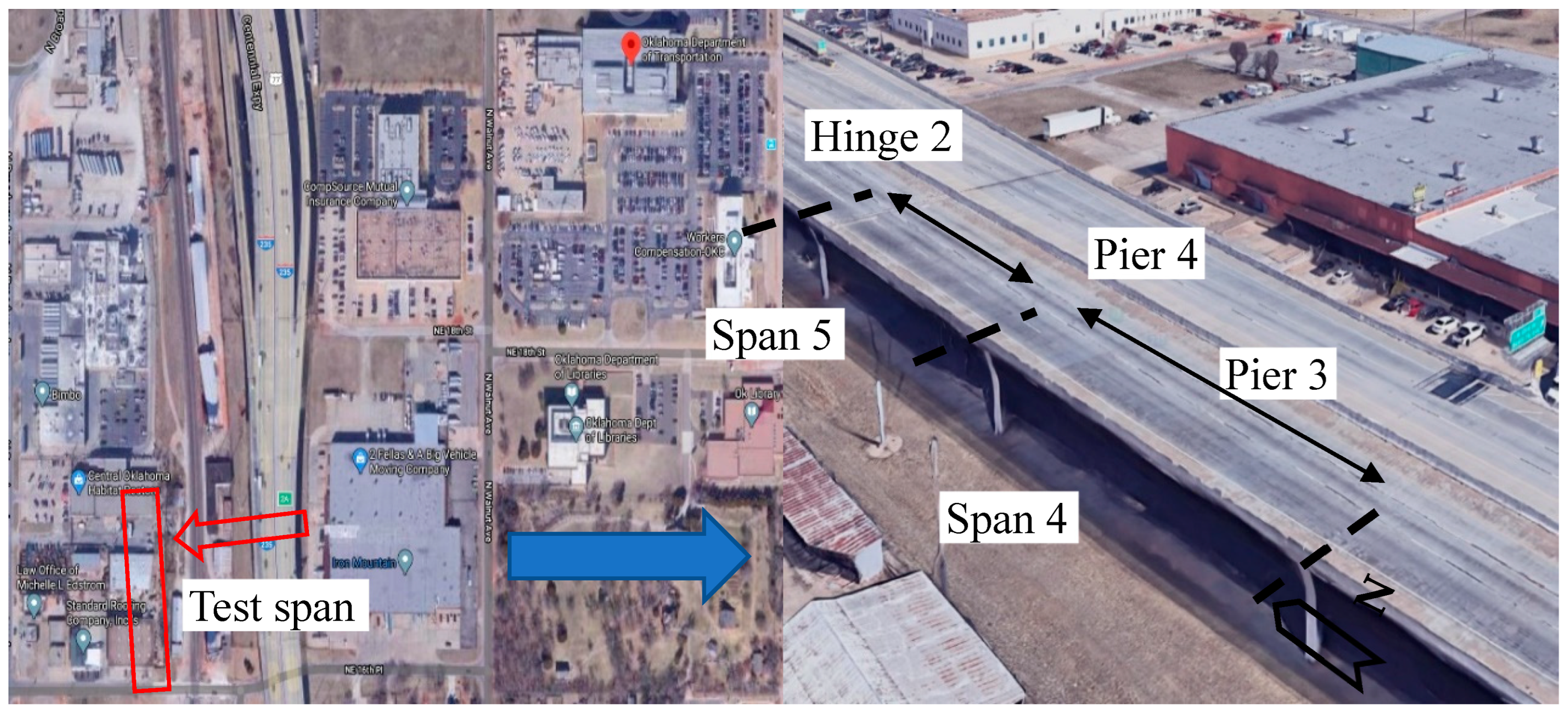
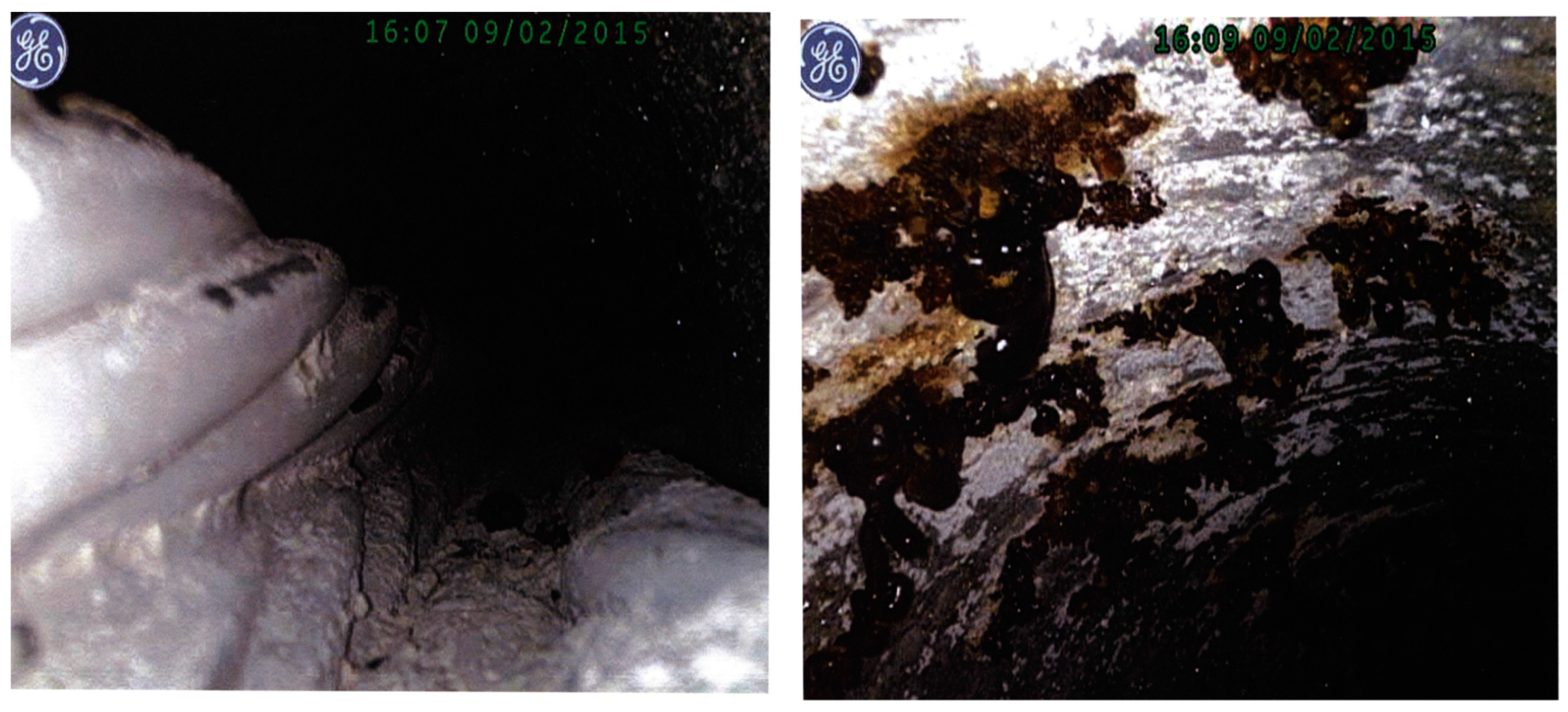
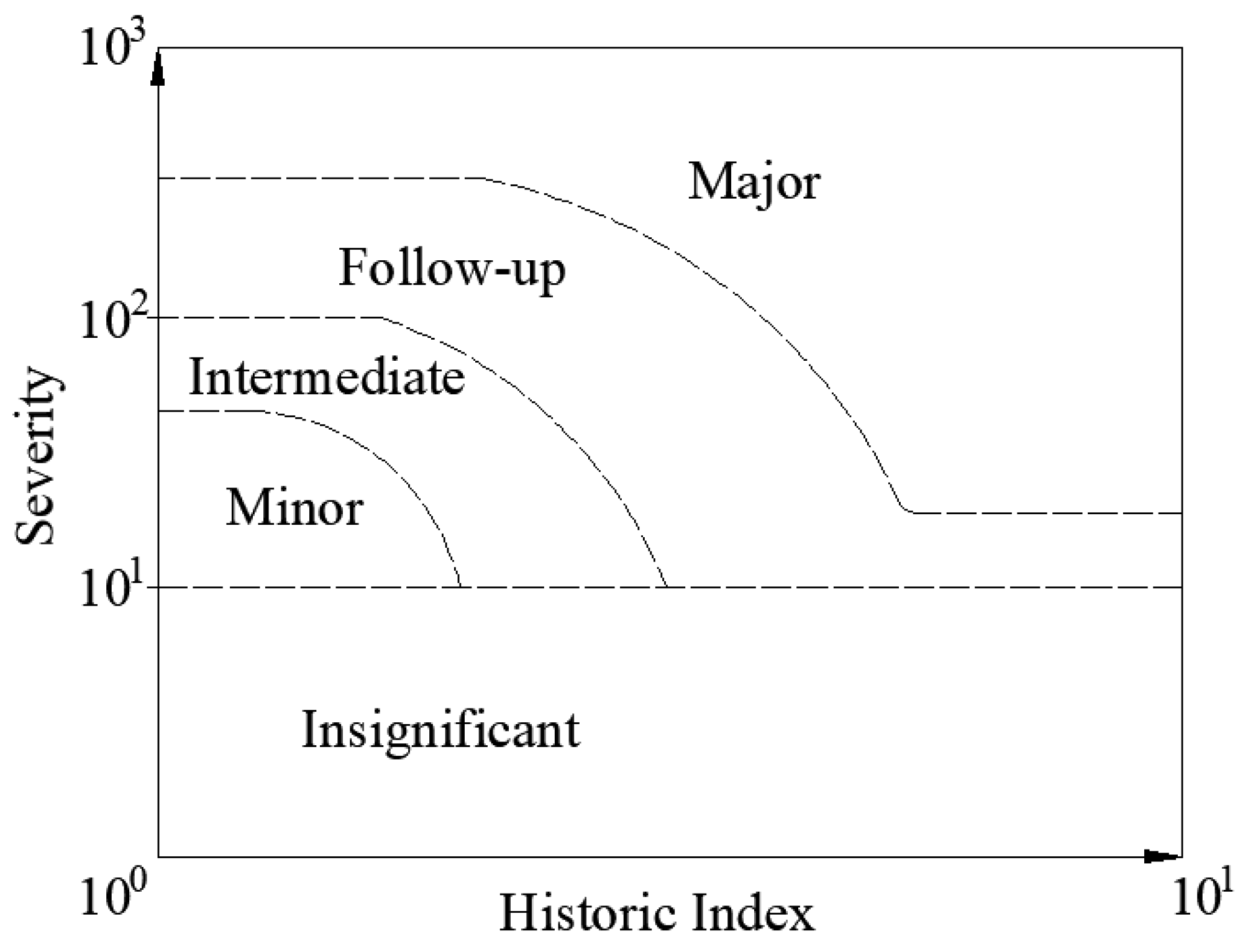




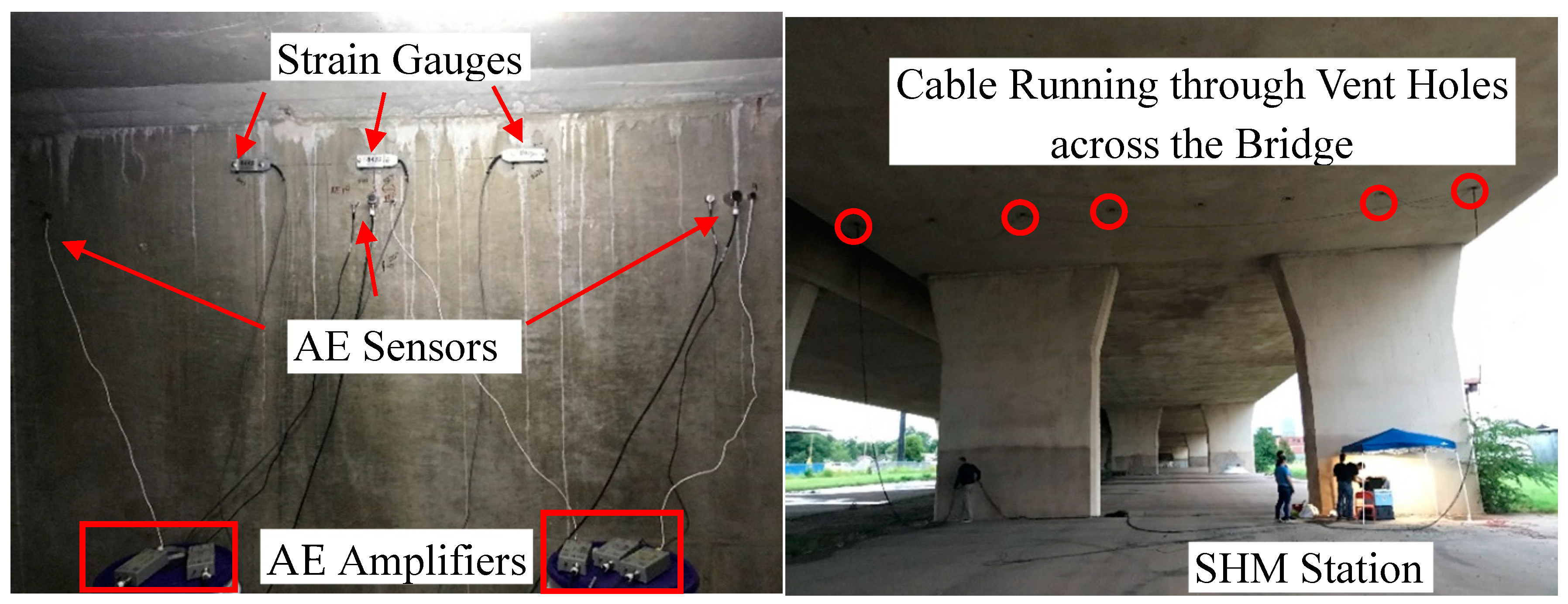


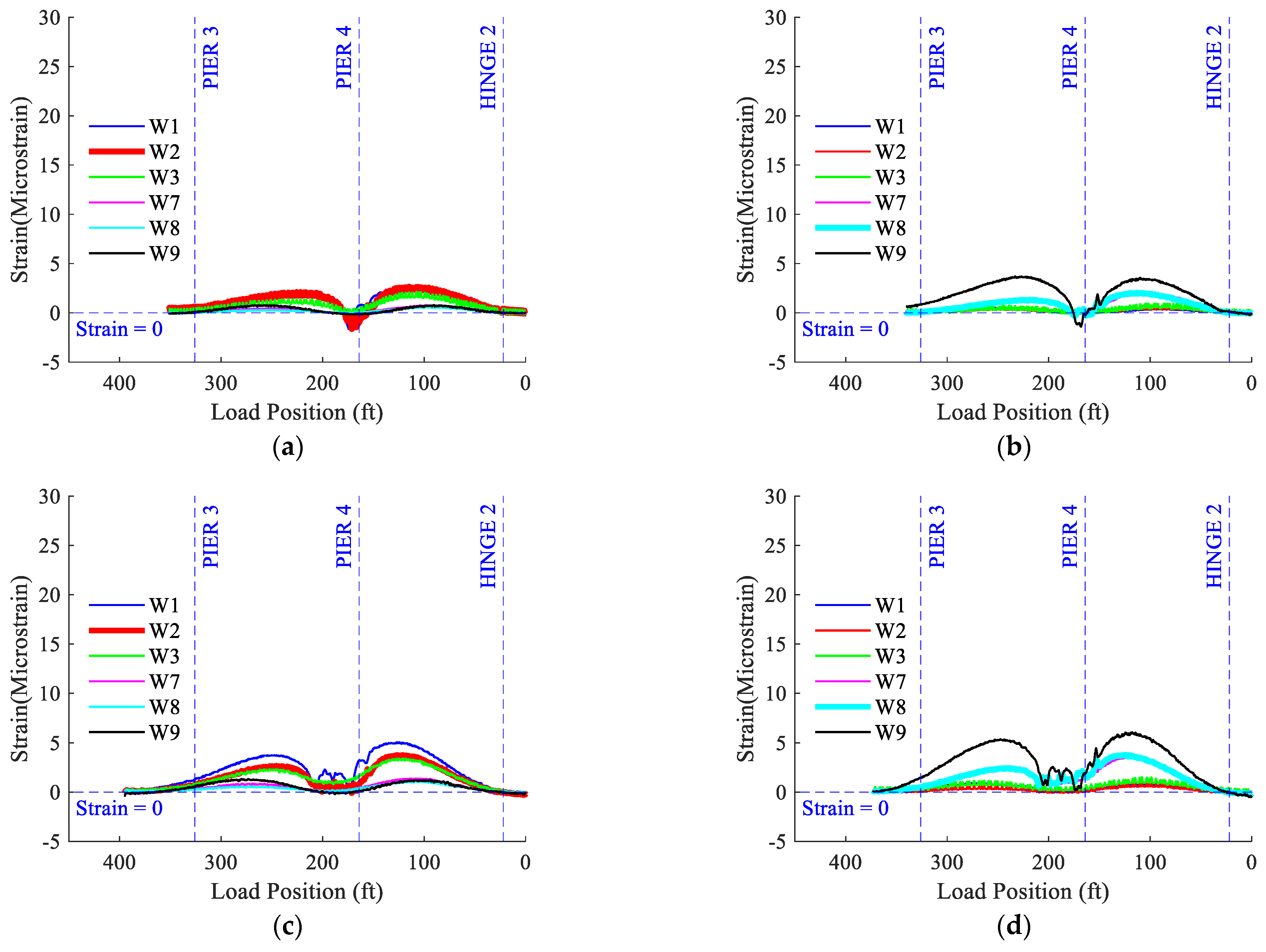
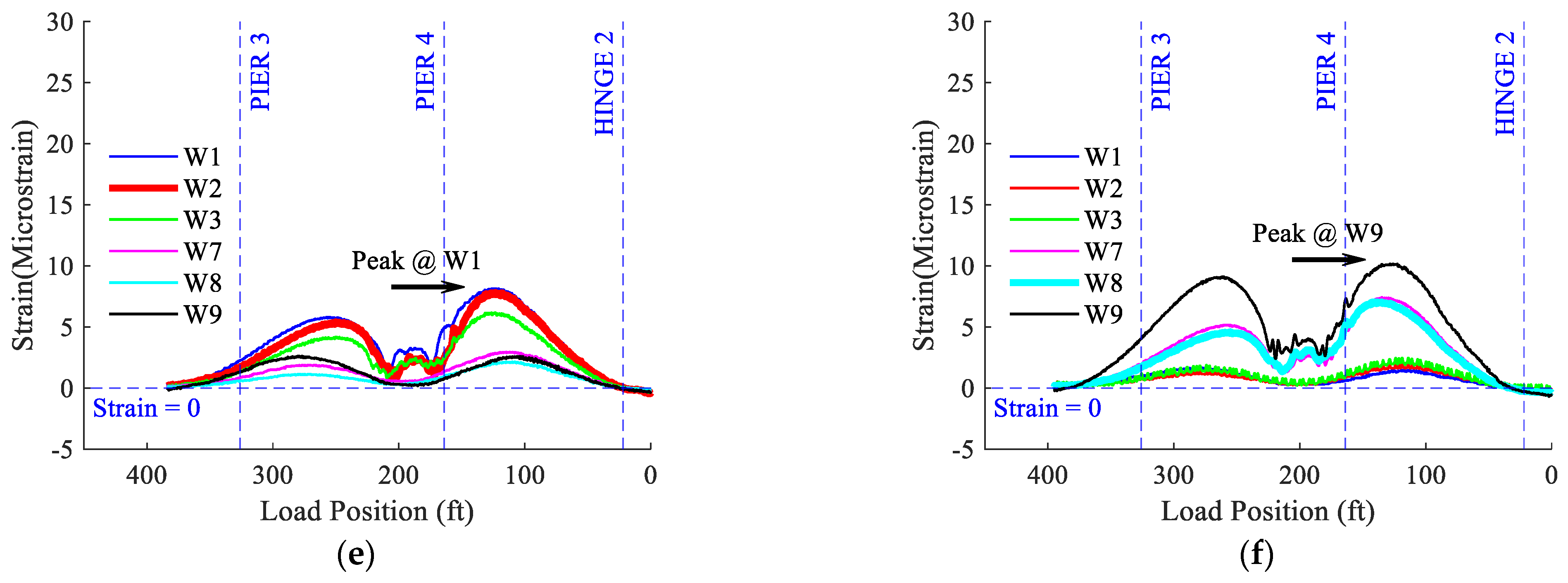
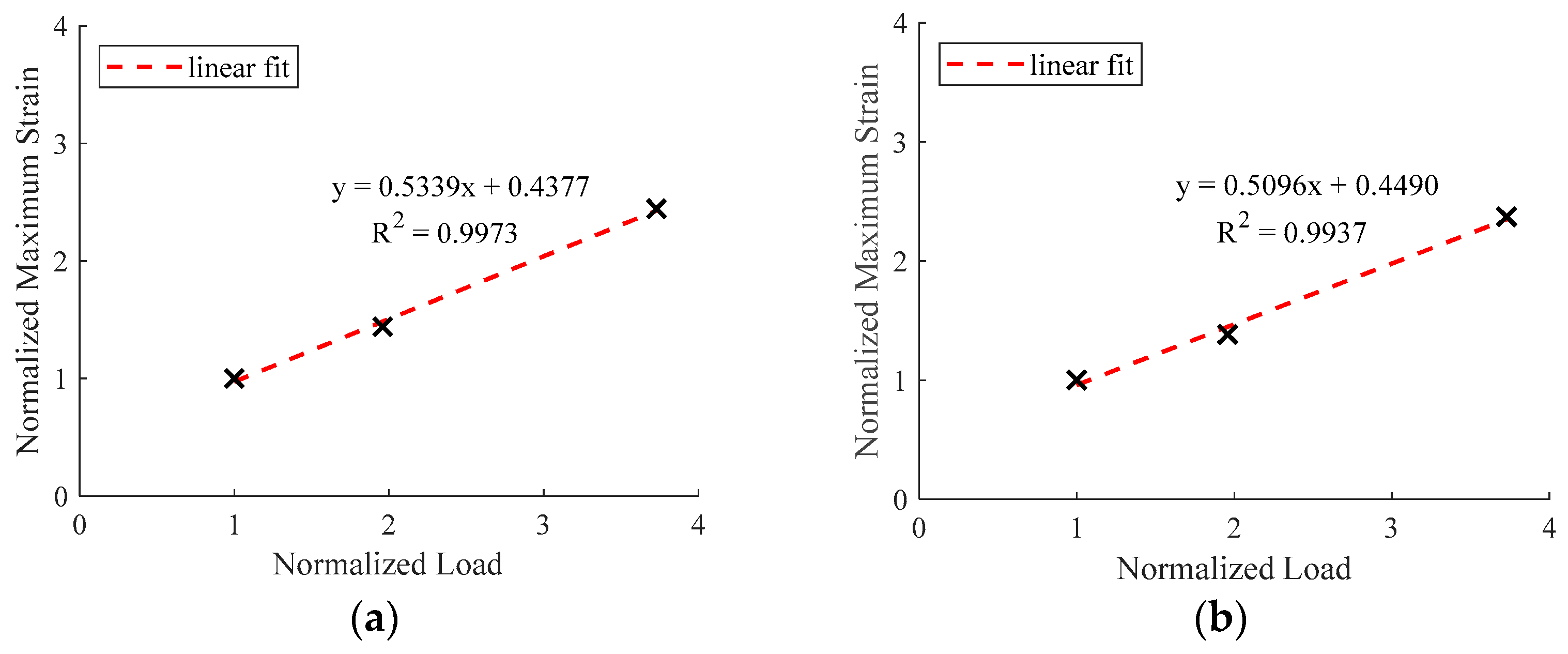
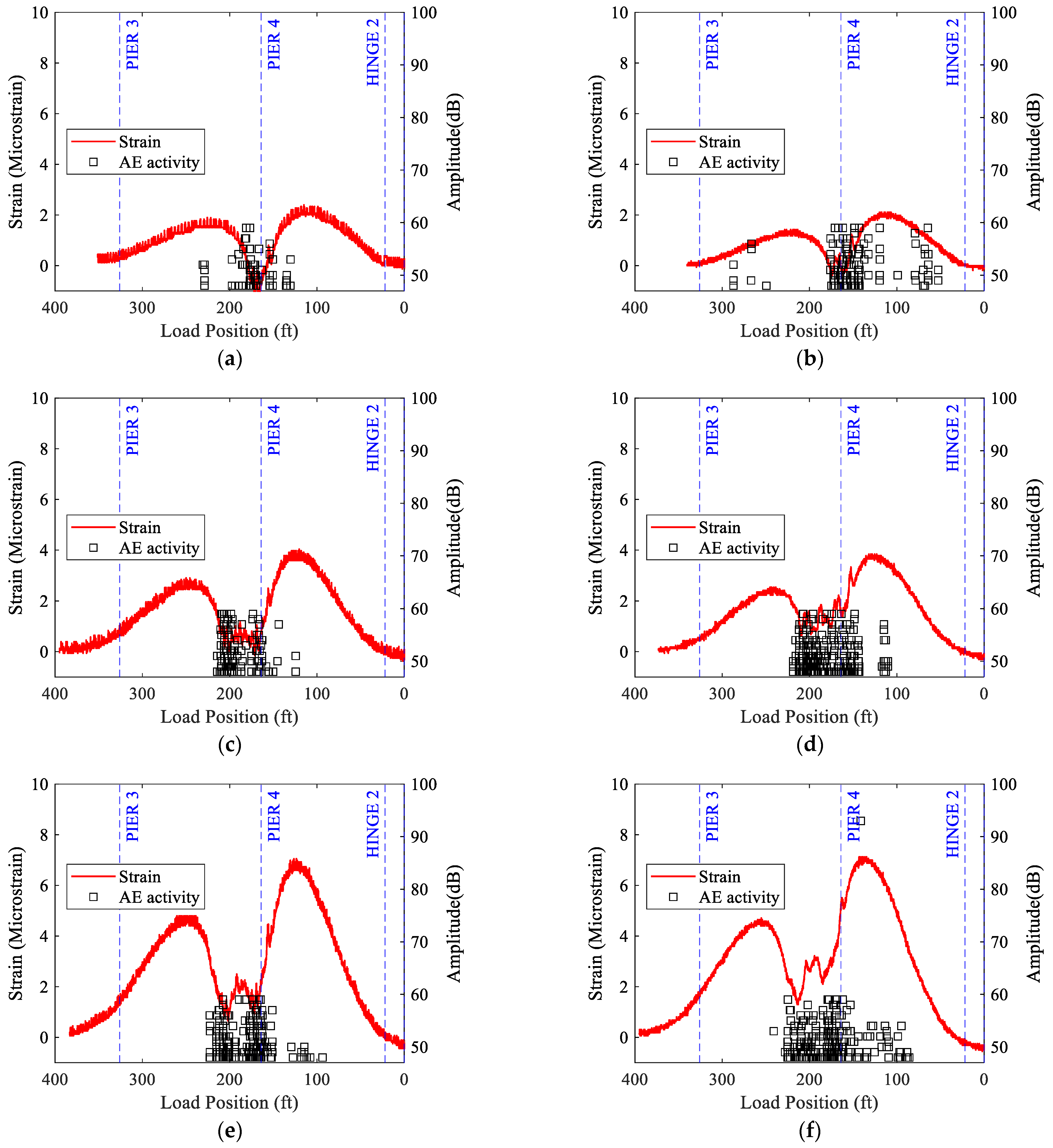
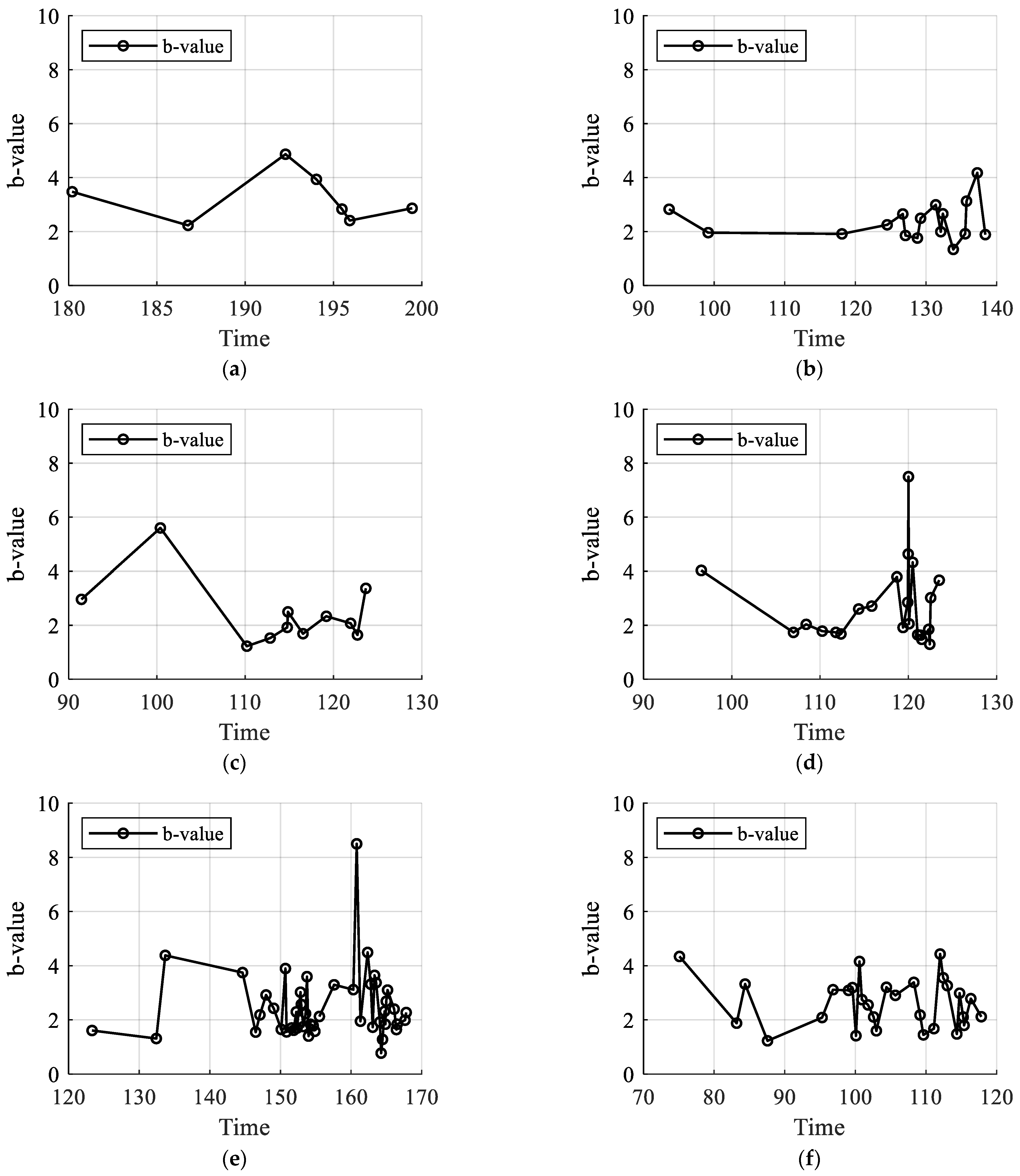
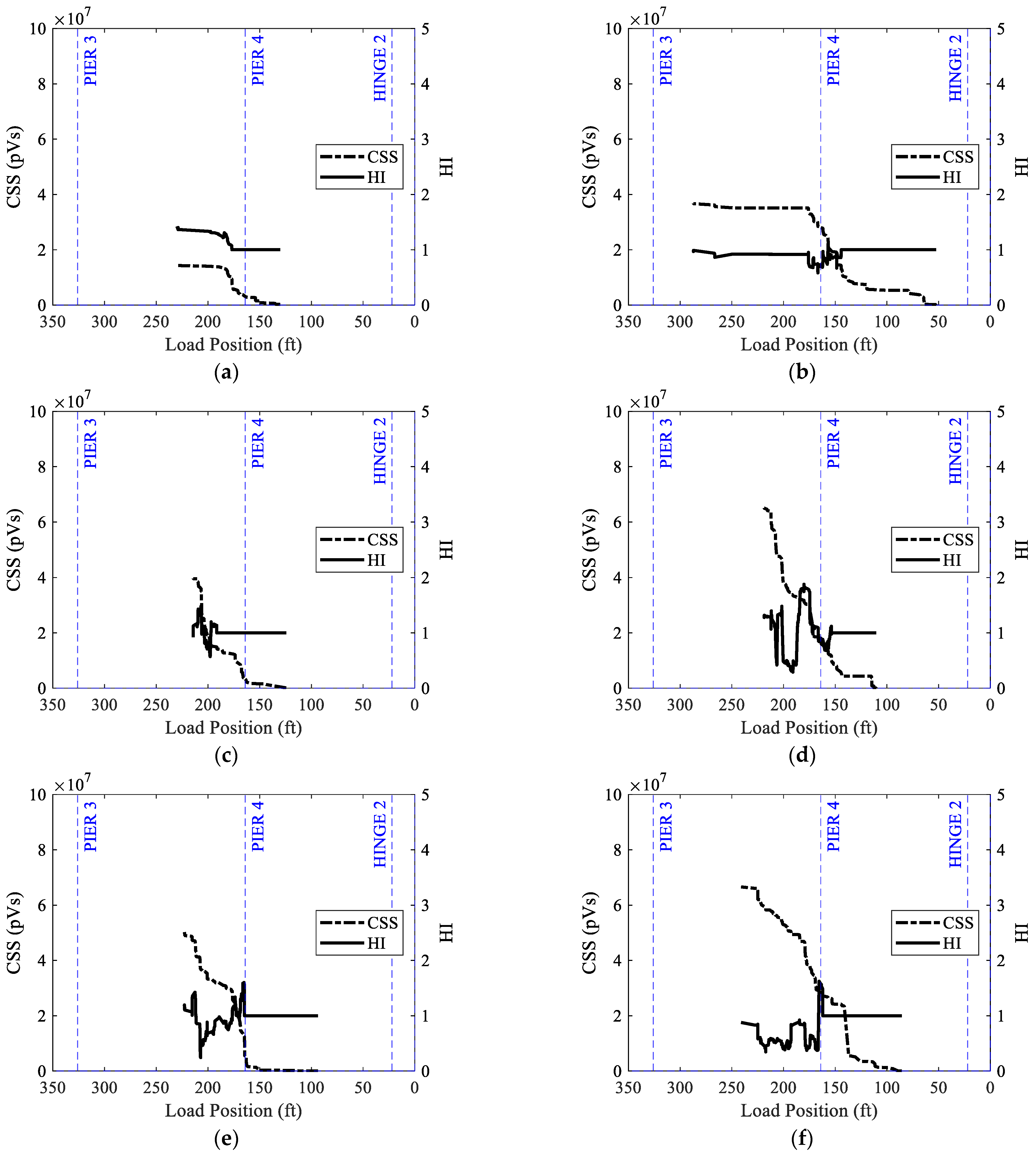
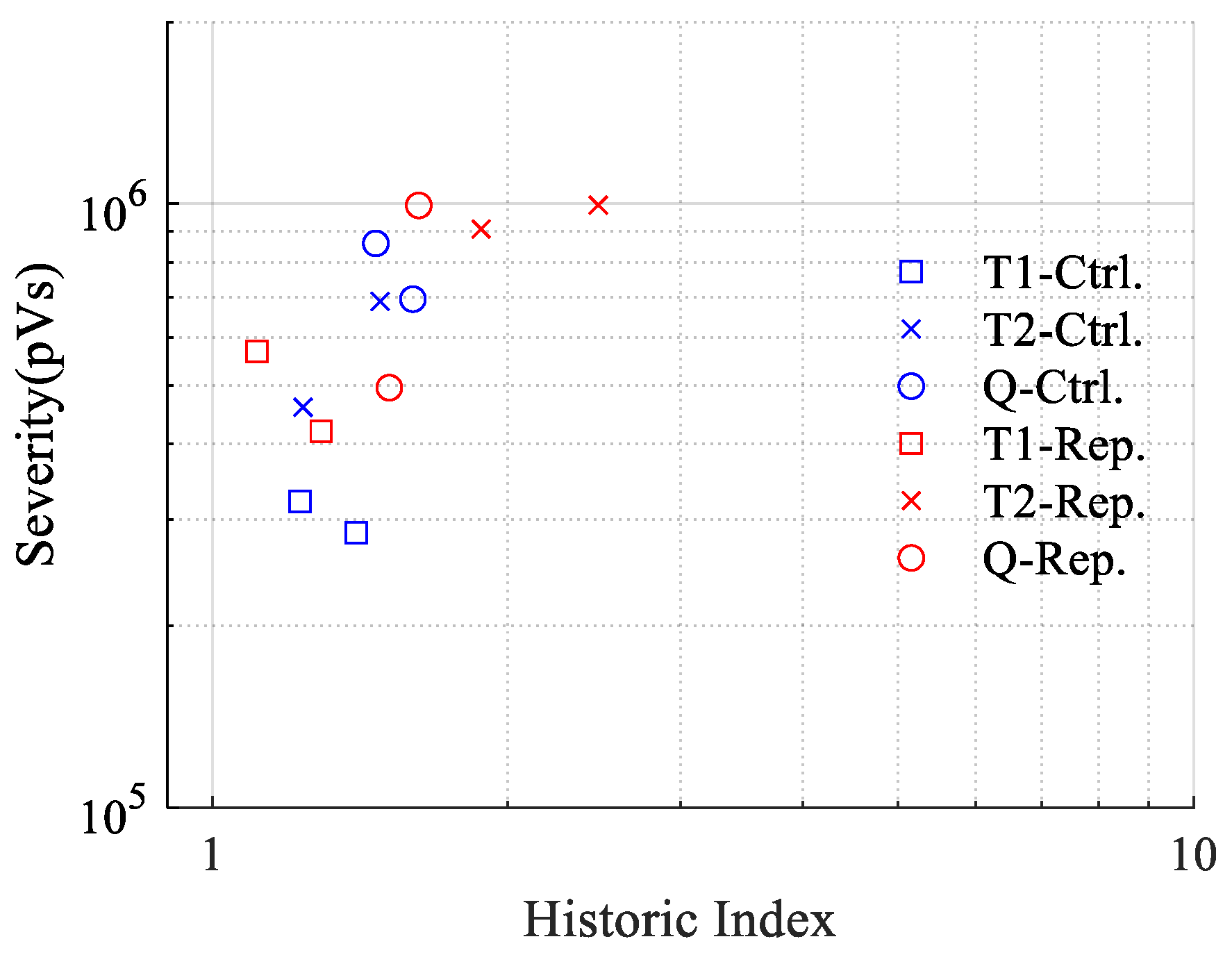
| Truck Label | Front Axle Wt. (Kips) | Rear Axle Wt. (Kips) | Gross Wt. (Kips) |
|---|---|---|---|
| #1 | 13.12 | 39.64 | 52.76 |
| #2 | 14.08 | 36.48 | 50.56 |
| #3 | 11.46 | 33.66 | 45.12 |
| #4 | 14.56 | 33.74 | 48.30 |
| Load Scenario | Total Weight (Kips) | Lane Tests | ||
|---|---|---|---|---|
| West Lane (WL) | Center Lane (CL) | East Lane (EL) | ||
| Truck 1 Series (T1) | 52.76 | T1-WL-P1(P2) | T1-CL-P1(P2) | T1-EL-P1(P2) |
| Truck 2 Series (T2) | 103.32 | T2-WL-P1(P2) | T2-CL-P1(P2) | T2-EL-P1(P2) |
| Quads Series (Q) | 196.74 | Q-WL-P1(P2) | Q-CL-P1(P2) | Q-EL-P1(P2) |
| Strain Response of W2 | Strain Response of W8 | F-Test (p-Value) | t-Test (p-Value) | ||||||
|---|---|---|---|---|---|---|---|---|---|
| L.P. | SG. Loc. | Avg. | CoV. | L.P. | SG. Loc. | Avg. | CoV. | ||
| T1-WL | Midspan | 9.02 | 18.19% | T1-EL | Midspan | 11.56 | 32.00% | 0.532 | 0.469 |
| Support | 2.73 | 17.75% | Support | 1.86 | 40.55% | 0.494 | 0.086 | ||
| T2-WL | Midspan | 12.93 | 16.92% | T2-EL | Midspan | 16.02 | 30.40% | 0.538 | 0.500 |
| Support | 4.43 | 5.74% | Support | 3.80 | 36.03% | 0.020 | 0.369 | ||
| Q-WL | Midspan | 21.60 | 14.57% | Q-EL | Midspan | 27.42 | 25.79% | 0.533 | 0.399 |
| Support | 8.00 | 8.39% | Support | 7.15 | 35.78% | 0.053 | 0.545 | ||
Disclaimer/Publisher’s Note: The statements, opinions and data contained in all publications are solely those of the individual author(s) and contributor(s) and not of MDPI and/or the editor(s). MDPI and/or the editor(s) disclaim responsibility for any injury to people or property resulting from any ideas, methods, instructions or products referred to in the content. |
© 2025 by the authors. Licensee MDPI, Basel, Switzerland. This article is an open access article distributed under the terms and conditions of the Creative Commons Attribution (CC BY) license (https://creativecommons.org/licenses/by/4.0/).
Share and Cite
Zeng, H.; Hartell, J.A.; Emerson, R. Evaluation of Performance of Repairs in Post-Tensioned Box Girder Bridge via Live Load Test and Acoustic Emission Monitoring. Infrastructures 2025, 10, 56. https://doi.org/10.3390/infrastructures10030056
Zeng H, Hartell JA, Emerson R. Evaluation of Performance of Repairs in Post-Tensioned Box Girder Bridge via Live Load Test and Acoustic Emission Monitoring. Infrastructures. 2025; 10(3):56. https://doi.org/10.3390/infrastructures10030056
Chicago/Turabian StyleZeng, Hang, Julie Ann Hartell, and Robert Emerson. 2025. "Evaluation of Performance of Repairs in Post-Tensioned Box Girder Bridge via Live Load Test and Acoustic Emission Monitoring" Infrastructures 10, no. 3: 56. https://doi.org/10.3390/infrastructures10030056
APA StyleZeng, H., Hartell, J. A., & Emerson, R. (2025). Evaluation of Performance of Repairs in Post-Tensioned Box Girder Bridge via Live Load Test and Acoustic Emission Monitoring. Infrastructures, 10(3), 56. https://doi.org/10.3390/infrastructures10030056






